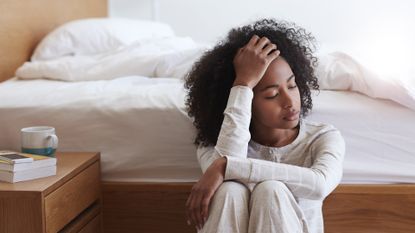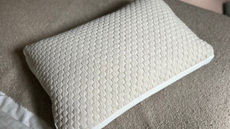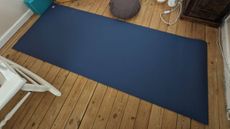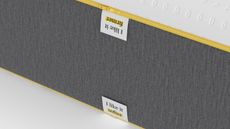We’ve all got a friend who can fall asleep at the drop of a hat, wherever they are. Wouldn’t you like to be like that? Well, we're not promising miracles, but there are a number of commonly used tips and techniques that can help you nod off more quickly, perhaps in a matter of minutes.
First of all, however, you need to make sure you’re not sabotaging your ability to fall asleep naturally. So if you generally experience trouble sleeping, make sure you read our articles on how to sleep better, as well as checking for these reasons you might be waking up at night. Ready? Okay, let’s delve into some tried and tested approaches for falling asleep super-quickly...
- Can't get comfy? Head to our best mattress guide and upgrade your sleep setup
- Now's a good time to buy: browse the best cheap mattress deals live now
- Keep an eye on progress with one of the best best sleep tracker
1. Brain Tapping
Jim Donovan is a professional musician and assistant professor who’s on a mission is to share the healing power of music. In his TEDX Talk ‘How to trick your brain into falling asleep’, which you can watch above, he demonstrates a technique called Brain Tapping that involves nothing more complicated than tapping out a rhythm.
The exercise starts by bringing your hands onto your lap and tapping it lightly, at the speed of a ticking stopwatch. Then you keep slowing the rhythm down, and slowing your breathing, until you start to fall asleep. Jim notes that it may not work first time, but if you keep practising for five nights, you’ll soon be dropping off more quickly and getting better quality sleep as a result.
2. Visualising tiredness

In his book I Can Make You Sleep, hypnotist and therapist Paul McKenna argues that many people find it difficult to sleep because they’ve trained their brains to follow a different pattern than the correct one. This might mean, for example, that rather than sleeping after getting into bed, you automatically start thinking about your problems. The solution, Paul argues, is simply to retrain your brain.
He suggests many exercises in his book to help you do this in practice. One begins by remembering a time when you felt very tired, and how your body felt. Once that’s established in your mind, imagine you’re surrounded by friends who all feel just as tired. Visualise one of them yawning, then another, then another. Imagine how more and more of them are having difficulty keeping their eyes open. Then visualise yourself yawning and struggling to keep your eyes open (even if they are actually shut) and explore what that feels like.
You get the idea… the aim is to use the power of your imagination to summon up a scenario where you’re fighting to stay awake. And it can be surprisingly effective and fast-acting when you try it.
- Check out our tips for how to stop snoring
3. Use the 4-7-8 technique

The 4-7-8 breathing technique is a breathing pattern developed by Dr. Andrew Weil. Based on an ancient yogic technique called pranayama, it’s broadly aimed at relaxing you, rather than falling asleep per se. But if you’re in bed, and it’s an appropriate time of night, there’s no reason it can’t be used to help you fall asleep quickly and soundly.
To begin, make a whoosh sound by exhaling completely through your mouth. Next, close your mouth and quietly inhale through your nose, counting to 4 in your mind. Now hold your breath for 7 seconds, then exhale by making a whoosh sound again, for a count of 8. Repeat this cycle another three times, making 4 breaths in and out in total. This will make you feel super-relaxed and “in the zone”. Then try breathing normally... if you’re still awake, that is.
4. Use the military technique

Here’s a trick detailed in the 1981 book by Lloyd Bud Winter: Relax and Win: Championship Performance that was reportedly used by the US army to help them fall asleep in conflict situations that are not exactly conducive to relaxation. According to Winter, they discovered this technique worked for 96% of recruits who tried it for six weeks.
You begin by relaxing the muscles in your face. First tighten up, and then loosen your tongue, jaw and the muscles around the eyes. Once your face feels like gloopy putty, drop your shoulders as far down as they’ll go, while breathing in and out and listening to the sound of your breath. Continue by relaxing your upper and lower arm, one side at a time, then your chest, and then your legs, beginning from the thighs and working downwards.
Once you’re physically relaxed, spend 10 seconds trying to clear your mind, before thinking about one of two scenarios: either lying in a canoe on a calm lake with a clear blue sky above you, or lying in a black velvet hammock in a pitch-black room. Alternatively, if you’re not good at visualisation, just chant the mantra: “Don’t think, Don’t think, Don’t think” to yourself over and over for about 10 seconds.
5. Take a hot bath

Find breathing and relaxation exercises too complex? Then we’ll end with a tried and tested method of getting to sleep quickly that’s as simple as they come: get out of a hot bath or shower and head straight for bed.
A 2019 report published by The University of Texas found that bathing before bed, ideally for 90 minutes in water at 104-109F (40-43C) can help you fall asleep an average of 10 minutes quicker than normal.
You might think this works by getting you nice and warm, but it’s actually the opposite. Although your face, hands and feet feel flushed after getting out of a hot bath, that heat is being drawn out of the inside of your body. So it's actually the cooling of your core temperature that signals to your body that it's time to go to sleep.











